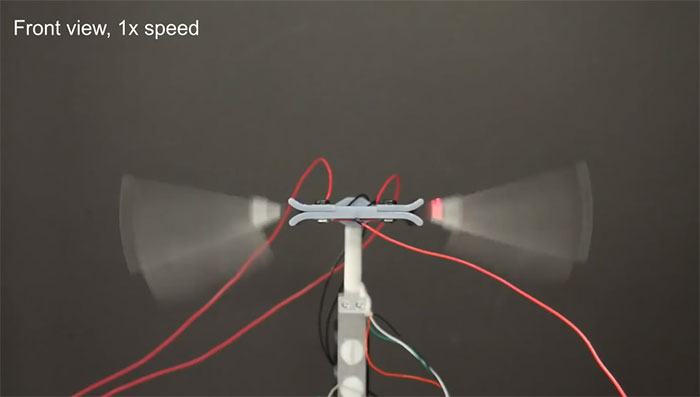Successfully developed a robot that flaps its wings more efficiently than insects
UK's University of Bristol has successfully developed a robot that can flap its wings and generate more power than insects of the same size.
When it comes to flying robots, the researchers mainly use propeller-based designs. Although bio-inspired wing flapping methods have proven to be much more efficient, replicating them in machines remains a major challenge. Using motors, gears and drivetrains to achieve flapping motion adds complexity as well as weight to the entire robot, causing many undesirable effects.
Led by Professor Jonathan Rossiter, a team of researchers at the University of Bristol have recently developed a direct-drive artificial muscle system that allows the robot to achieve a flapping motion without using using rotating parts or gears.
Insect-inspired flapping robot developed by the University of Bristol. (Video: SoftLab Bristol)
Called a Liquid Amplified Zipper Actuator (LAZA), the mechanism consists of an electrode dipped in a liquid dielectric and moved up and down by activating electric fields above and below it, using oppositely charged electrode. The team then added two wings and adjusted the thrust generated by the flapping motion.
"With LAZA, we apply electrostatic forces directly to the wing, rather than through a complex, inefficient powertrain. This leads to better performance and a simpler design that unlocks for development of low-cost, ultra-small aircraft for future applications," said Dr. Tim Help, one of the developers of the LAZA system.

Fluid amplification zipper actuator.
The researchers tested the system for more than a million flapping cycles to demonstrate that robots built with this mechanism could perform long-distance flight. They also discovered that their prototype produced more energy than the insect it inspired, with a flight speed of 0.71 m/s.
"LAZA is an important step forward for microscopic autonomous flying robots like insects - machines that promise to perform many important environmental tasks such as pollinating crops, or searching for lost people. remains in collapsed buildings," Rossiter added in the press release.
- NASA tested the new FlexFoil flaps on aircraft
- The robot flaps its wings like butterflies
- US made the first robot bee
- Switzerland successfully developed the eel robot to detect domestic pollution
- Flying robots reveal secrets about the aerial world of insects
- Rainy insects are like humans who 'eat' a whole bowling ball in their face, but why don't they die?
- Admire the beautiful, exotic butterflies in Vietnam
- Flying robot like seagull
- The cicadas are red and red,
- Robot reproduces the evolution of the organism's ability to fly
- The first fish swimming fast, swimming like fish
- Germany developed the most advanced robot in the world
 The US company is about to build a supersonic passenger plane of 6,000km / h
The US company is about to build a supersonic passenger plane of 6,000km / h Japan develops avatar robot as in fiction film
Japan develops avatar robot as in fiction film Australia tested the world's first mango picking robot
Australia tested the world's first mango picking robot America develops technology to separate water from animal waste
America develops technology to separate water from animal waste Andean Condor - A bird that can fly for 5 hours without flapping its wings
Andean Condor - A bird that can fly for 5 hours without flapping its wings  Why can hummingbirds float without falling?
Why can hummingbirds float without falling? 